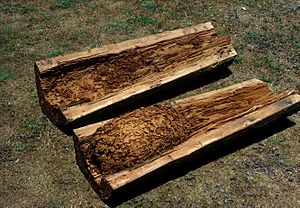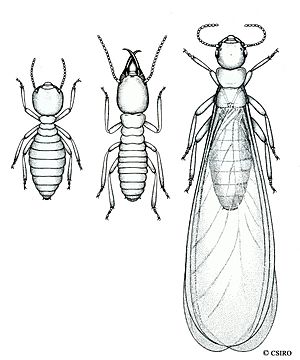Coptotermes acinaciformis facts for kids
Quick facts for kids Coptotermes acinaciformis |
|
|---|---|
| Scientific classification | |
| Kingdom: | |
| Phylum: | |
| Class: | |
| Order: | |
| Infraorder: | |
| Family: |
Rhinotermitidae
|
| Genus: |
Coptotermes
|
| Species: |
C. acinaciformis
|
| Binomial name | |
| Coptotermes acinaciformis (Froggatt, 1898)
|
|
Coptotermes acinaciformis is a type of underground termite found in Australia. These termites are social insects, meaning they live together in large groups. They build a shared home, called a nest. This nest can be inside the bottom part of a tree or hidden underground.
From their nest, they dig a network of tunnels through the soil. These tunnels let worker termites search for food without coming out into the open. C. acinaciformis can cause a lot of damage to trees and wooden parts of buildings.
What is a Termite Colony?
C. acinaciformis builds its nest at the bottom of a tree trunk or deep underground. Sometimes, they even create a mound above ground. Long tunnels, up to 50 meters (164 feet) long, spread out from the nest. These tunnels help the worker termites find other sources of wood to eat.
Smaller nests can also be built in places like wall cavities inside buildings. But these spots must have some moisture, perhaps from a leaky pipe. A very large colony can have more than a million termites living together!
When a nest is in a living tree, the termites eat out the center. They replace it with a material called frass, which is like termite waste. They can also tunnel into other nearby trees through the bark. Tree stumps and fallen logs in the area are often attacked too. Termite tunnels from one colony can spread over an area as big as 0.4 acres.
Another favorite nesting spot is where soil has been moved for building. If pieces of wood are accidentally buried in moist soil, termites might build a nest there. This can happen under patios or around new buildings.
Meet the Termites
There are several types of termites in Australia, and they can be hard to tell apart. C. acinaciformis looks a lot like C. frenchi or C. lacteus. However, the soldier termites of C. acinaciformis are a bit bigger. They are about 5 to 6.5 millimeters long.
If you look at them from above, the soldiers of C. frenchi and C. lacteus have pear-shaped heads. But C. acinaciformis soldiers have heads that look more like a rectangle.
The termite lifecycle begins when winged termites fly out of an old nest. This is called a nuptial flight. After flying, they land, shed their wings, and look for a good place to start a new colony. This is usually a piece of rotting wood buried in damp soil or a decaying spot at the base of a tree.
The first eggs laid by the queen hatch into workers. Once these workers are grown, they take over caring for the young. This allows the queen to focus on laying eggs for the rest of her life. It usually takes three to five years for a colony to grow large enough to cause damage to buildings.
Where Do They Live?
C. acinaciformis is the most common termite in Australia. You can find them almost everywhere in the country. The only places they don't live are Tasmania, parts of coastal Victoria, and a few other areas with a lot of rain. They live in both forests and cities, especially where trees are close to buildings.
Termite Research
Scientists have studied these termites. They found that if a termite is separated from its colony for a while and then brought back, the other termites will recognize and accept it. But if a termite from a different nest tries to join, it will be rejected by the colony.



